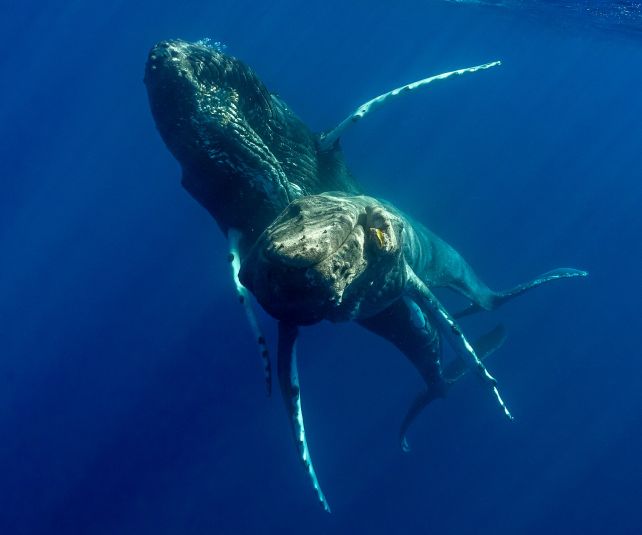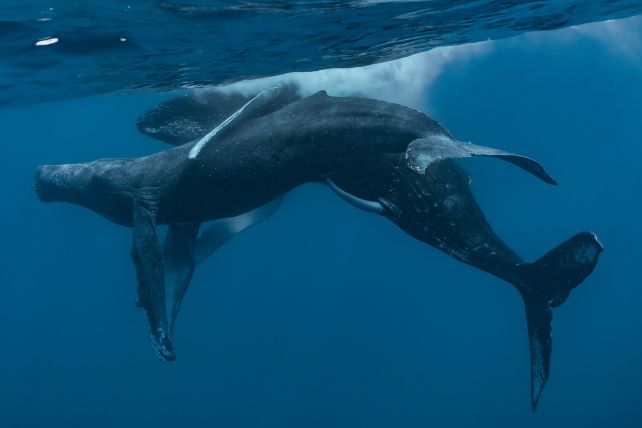ARTICLE AD
A physical encounter between two humpback whales has been immortalized on film for the first time.
As two photographers snapped pictures off the coast of Maui, they were approached by a pair of humpbacks (Megaptera novaeangliae); one of whom was proceeding to engage in repeated sexual behavior with his companion.
But there were some surprises about the encounter – not least of which was that both whales were adult males.
Pacific Whale Foundation biologist Stephanie Stack is the senior author of a paper describing the interaction, which has been published in Marine Mammal Science.
"Although this is the first time it has been reported for humpback whales, homosexual behavior is common in the animal kingdom and well documented for many species of cetaceans," reads a post on the the Pacific Whale Foundation's blog.
"The first documented copulation between humpback whales adds valuable details and knowledge toward our understanding of these magnificent creatures, offering fresh insights into the reproductive behavior of this species."
 The two adult humpback males were observed engaging in sexual behavior. (Lyle Krannichfeld and Brandi Romano)
The two adult humpback males were observed engaging in sexual behavior. (Lyle Krannichfeld and Brandi Romano)The social behaviors and migration patterns of humpback whales are fairly well documented, but their reproductive activities remain something of a mystery. Their copulation has never been documented before, and sightings of humpback whale penises are few and far between.
It's obvious that humpback whales do reproduce, but copulation – as throughout the animal kingdom – is not exclusively a reproductive act. Cetaceans in particular can engage in sexual activity to practice their moves (so to speak), to improve social bonding, to enforce or reinforce dominance, reduce the reproductive opportunities for other individuals, or to ease social tensions.
A lot of the time, sexual activity occurs between individuals of the same sex. Dolphins, gray whales, and orcas have all been documented engaging in some same-sex hanky panky.
While we can now add humpback whales to that list, the encounter presented an unexpected twist.
It was documented by photographers Lyle Krannichfeld and Brandi Romano, who first noticed the two whales as they approached their private boat. One of the whales, they saw, seemed to be in poor health. He was thin, covered in lice, and had a significant injury on his lower jaw, possibly from being hit by a ship.
The second whale, who seemed in excellent physical condition, had his penis extruded for the entire interaction. He repeatedly approached his unwell companion, holding him in place with his pectoral fins, and repeatedly penetrating the genital slit – the opening to the orifice in which the penis is usually concealed – with his own penis.
 The second whale was observed penetrating the first whale several times. (Lyle Krannichfeld and Brandi Romano)
The second whale was observed penetrating the first whale several times. (Lyle Krannichfeld and Brandi Romano)The first whale had obviously been unwell for some time, and may have been dying. This makes the encounter a curious one for researchers to explain, with several possible reasons for the sexual behavior of the second whale.
One might have been the reinforcement of a social bond with an ailing friend. But there are less benign explanations, too. The second whale may have been asserting dominance over a weaker male, or trying to make himself seem larger and more physically fit by comparison. The first whale was seen to adopt a posture that may have been defensive at several points. The researchers suggest that this could mean that the sexual behavior was unwelcome, but the sick whale wasn't strong enough to fight about it.
Quite frankly, the observations raise many more questions about the sexual behavior of humpback whales than they answer.
"The documented instance of male-male nonreproductive behavior presented here, including the unique case of an apparently injured and ailing whale being penetrated by a seemingly healthy counterpart, raise intriguing questions about the nature of such behavior in humpback whales," the researchers write in their paper.
"The limited data available on this behavior emphasizes the need for further research to explore the motivations, implications, and potential factors influencing such interactions, especially in the context of healthy individuals."
The team's paper has been published in Marine Mammal Science.

 11 months ago
62
11 months ago
62 

